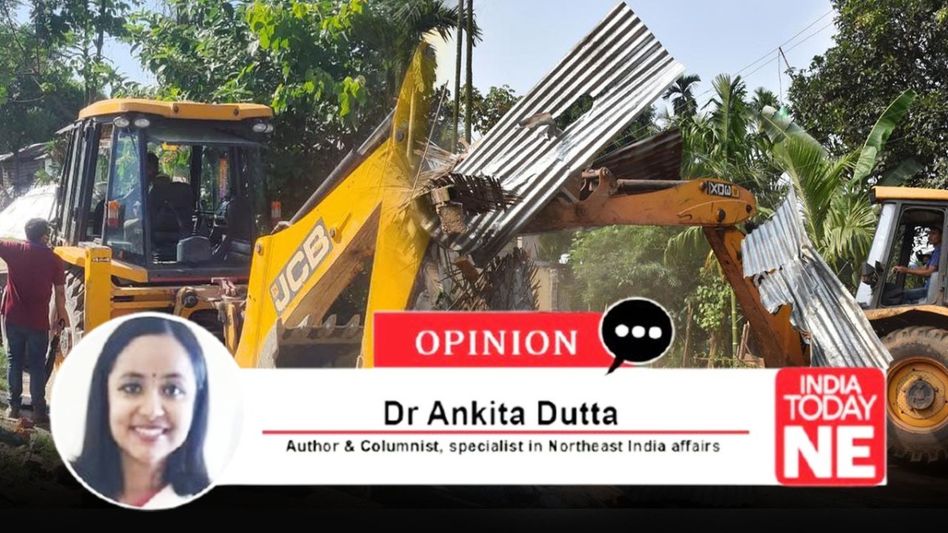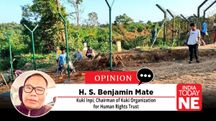Encroachment and evictions: Assam Government’s decisive action
The recent eviction of more than a thousand families from at least 3,500 bighas of land in Charuwa Bakra, Chirakuta, and Santoshpur villages in Dhubri district saw resistance from the local Muslims, who not only damaged excavators but also attacked our Police forces, thereby prompting the latter to resort to baton charges for controlling the situation.

The incident of illegal Bangladeshi immigrants and land-grabbers firing at Assam Police personnel during the eviction drive at Dholpur-Gorukhuti village under Sipajhar revenue circle in Darrang district’s Mangaldoi Lok Sabha constituency in 2021 is now repeating itself again in different places of Assam.
The recent eviction of more than a thousand families from at least 3,500 bighas of land in Charuwa Bakra, Chirakuta, and Santoshpur villages in Dhubri district saw resistance from the local Muslims, who not only damaged excavators but also attacked our Police forces, thereby prompting the latter to resort to baton charges for controlling the situation.
During the eviction drive in Goalpara’s Paikan Reserve Forest too, one person was killed and several others, including police personnel, sustained grievous injuries. While the drive began peacefully, violence erupted when some evictees reportedly began pelting stones and attempted to damage the excavators. Police fired warning shots into the air to control the situation, but one person was killed and several others injured.
Carrying out eviction drives in illegally occupied areas of any state is a legitimate right and duty of any Government. These actions should have been undertaken much earlier in a state like Assam.
Political appeasement and environmental neglect, especially from 2004 to 2012 allowed illegal settlements to expand in different parts of the state, especially regions like Rakhyasini Pahar and Paikan Reserve Forest in Goalpara where eviction drives were carried out recently. Instead of communalising the issue as many are trying to do, we need to understand its political, economic, and demographic implications for Assam and the Assamese. In fact, it is more a matter of saving the Assamese community’s cultural and civilisational pride, and not simply its religious identity.
The H.S. Brahma Committee for the Protection of Land Rights of Indigenous People that was constituted by the Sarbananda Sonowal Government in 2016, had submitted a detailed Report to the Government on the problem of land encroachment in Assam. As per the Report, 63 lakh bighas of Government land was estimated to be under illegal occupation, an area twice the size of Goa! The Report further pointed out that all lands in the riverine (char) areas of Assam are settled by a well-established institution called Matabbar or Dewani. The modus operandi of the Matabbar is to use the immigrants as a medium for grabbing the lands of the native residents through means, fair or foul. In many instances, the immigrants also try to legally possess cultivable land. For all practical purposes, the Matabbar has been playing the role of the Government, doling out and making allotments of land. They are landlords, with sprawling estates wielding tremendous political and financial clout, which dissuades others from raising a voice against them.
Over the years, ignorance and absence of Governmental control over the vast stretches of char lands along the Brahmaputra near the India-Bangladesh provided a fertile ground for illegal elements to carry on with their criminal activities. It is said that illegal immigrants easily find shelter in the char lands before moving into the heartland of Assam and occupying forests, Village Grazing Reserves (VGRs), etc. The process of completely evicting the illegal infiltrators from these lands is a tenuous one, for they are mostly Government lands or lands which have been procured through land mafias who force the owners to sell their plots at throwaway prices.
Land is indeed the most valuable and prized possession for the illegal infiltrators and many a times, it is also noticed that they are even ready to die than lose their land.
Several episodes in the socio-political history of Assam are proof enough of the fact that these encroachers are not the ones who would give up their landholdings so easily. The brutal attacks unleashed on the Police forces by protesters using sharp weapons, stones, machetes, and pointed bamboo sticks during the recent evictions are cases in point. They first pelt stones and then begin attacking the Policemen, eventually resulting in complete chaos. Such violence certainly cannot be a one-way traffic; there are many fringe elements and organisations involved which instigate the encroachers, who are given multiple notices beforehand to vacate the area. The security forces are left with no choice but to resort to firing in self-defence. If we recall, during the Gorukhuti eviction drive in 2021, certain shocking revelations had later come to light that pointed fingers at the role of the PFI behind instigating the encroachers to fire at the Police.
Nevertheless, such drives have to be a continuous process, in the larger interest of freeing the local people’s lands and Government lands from the occupation of illegal immigrants. In a welcome development, the Government of Assam has recently started a survey of the char areas of the state with the objective of ascertaining the number of people living there. It may be mentioned here that the Justice Biplab Sarma Committee formed by the Central Government for recommending measures for the implementation of Clause 6 of the Assam Accord had also suggested a detailed survey of the chars. However, only mapping the chars would not serve the desired purpose; because, accessing details of the people living there would be another major challenge. Some chars are of permanent nature, while some appear only during the winter season, remaining submerged during the monsoons. After every monsoon, new chars also appear on many tributaries of the Brahmaputra. The Government does not yet have an exact map of these chars and details of the people living there. We sincerely hope that the ongoing survey will bring out these and many other lesser-known details.
Moreover, to make Assam agriculturally self-sufficient and also provide employment opportunities to the local youth, it is very important that the Government effectively utilises all the evicted lands including the chars for farming. It might certainly not be possible to cultivate thousands of bighas of land simultaneously across the state. Hence, implementation of small-scale agricultural projects of 50 to 100 bighas on the lines of Gorukhuti in Darrang district and Kanyaka
Multipurpose Farm in Jamugurihat of Sonitpur district will provide adequate opportunities for the Assamese youth to become self-dependent while contributing to the state’s economic output. But, our youth will have to hang on despite all the difficulties including the annual monsoon floods. Even a short vacation of the site by our people will again see the re-occupation of all the evicted lands by the encroachers. It would require consistency and patience on the part of our youth, who are often blamed to be a lazy lot as compared to the extremely hard-working Muslim migrants.
This therefore, brings us to one of the most important questions – What can be a permanent and long-term solution to the problem of land encroachment in Assam? What needs to be accepted here is that over the years, the problem of encroachment of Government lands in several areas of the state never fell in the Government’s priority list. A thorough survey of the indigenous people in districts like Dhubri, Barpeta, Goalpara, South Salmara-Mankachar, Nagaon, etc. who became landless due to Islamic demographic invasion was never conducted. This only kept adding weight to an already expanding problem, since it left enough scope for the encroachers to claim that they are erosion-hit people. Based on our studies conducted on the subject in different parts of Assam, we have often observed that the people who encroach upon Government lands claim that they were erosion-affected or their farm lands were destroyed due to siltation after the annual floods. In such cases, the administration can always check their details and then cross-check them with the Revenue Officials of the respective places from where they initially came. But, this is normally not done as not many people are ready to take such pains to go through the rigorous bureaucratic process. It is precisely because of this reason that even persons who have land elsewhere, say in Dhubri district, have managed to illegally grab Government land somewhere else, say in Golaghat or Jorhat, claiming themselves to be landless.
Over the years, the district administration and forest officers, under whose jurisdiction the encroachments took place, preferred to look the other way when the encroachments began initially. Later, it became extremely difficult to evict the encroachers who have all the facilities of water supply and electricity connections in their respective locations. Are organisations like the Assam State Electricity Board (now Assam Power Distribution Company Limited) complicit in handing over power connections to these encroachers of Government lands?
Several hill areas surrounding the city of Guwahati have also been encroached upon. Large-scale encroachment of these hills around Guwahati began only after the shifting of Assam’s capital from Shillong to Dispur. At that time, there was no housing project for Class III and Class IV employees. The prices of lands skyrocketed in the city after the shifting of the capital. Hence, they preferred to grab land on the hills, facilitated by a politically influential network of land mafias and criminals. Gradually, people who flocked to the city in search of menial jobs, grabbed as much land as they could. The process continued in full steam as the Government never bothered to take a serious note of it. Another interesting aspect is that most of the encroachers of the hills around Guwahati are not landless people since they already own land elsewhere in the state.
In this context, the need of the hour is a detailed study of the real, ground-level situation of the extent of encroachment so that eviction drives that are to be undertaken in the near future are focused on all those of dubious nationality, surviving on encroached lands. Compiling data for such a detailed study definitely cannot be completed overnight. It will require time and diligence on the part of those entrusted with the task. One of the possible solutions can be the State Government carrying out a thorough survey of all the landless people in the state and then allotting small plots to them. After this is done, there must be strict vigilance and no one should be allowed to encroach upon Government lands. Also, the citizenship of the evicted people must be thoroughly checked, re-checked and cross-verified before allotting them land elsewhere. It would require extensive cooperation at all levels from the common citizens, so that all lands can be freed from the clutches of infiltrators. We have immense hope from schemes such as Mission Basundhara launched by the Government of Assam.
Assam is at a state of war against illegal immigrants. But this is not a class war. Neither it is a war cry sounded by the so-called Assamese middle class elite, as many Western progressivists, political theorists, and academics would like to depict or make us believe. The reality is that we are in the midst of a dangerous cultural and civilizational war. We the Assamese are not suffering from any mania of persecuting foreigners. We have always welcomed foreigners to our land. But, we can no longer tolerate illegal aliens. All we seek to protect is our identity at all costs. And that is natural. Every individual endeavours to preserve and promote his/her own identity and culture. This basic behavioural instinct of self-preservation is magnified whenever a particular race or ethnic group encounters the threat of being politically, economically, and culturally extinct in their own homeland. The pressing need for socio-economic security can be ignored only at one’s own peril.
Assam’s fight is equally against the encroachers as much as it is against their patronisers, occupying top posts in politics, bureaucracy, academia, think-tanks, etc. It is the latter who are adept at the art of crafting a narrative of Muslim victimhood every time an eviction takes place. The recent incidents are but only a small glimpse of the growing political and financial clout of the infiltrators/encroachers. Land is their primary target and will continue to remain ever so. Therefore, strict enforcement of land ownership laws, updating land surveys, and establishing legal accountability to protect Government and community lands are a must.
Copyright©2025 Living Media India Limited. For reprint rights: Syndications Today









